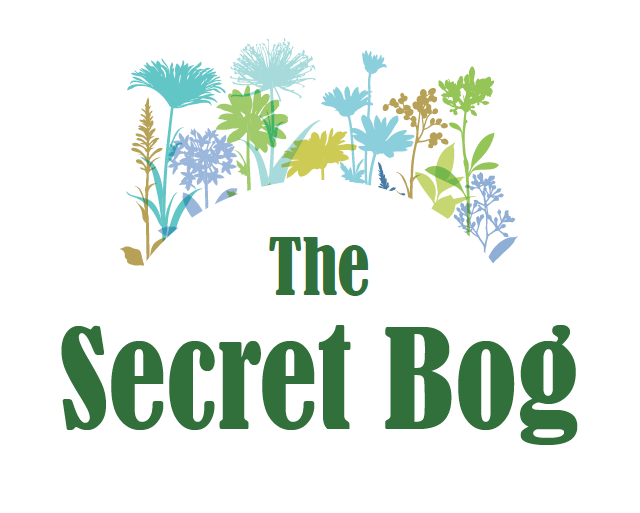
Story and Photos by William Burt
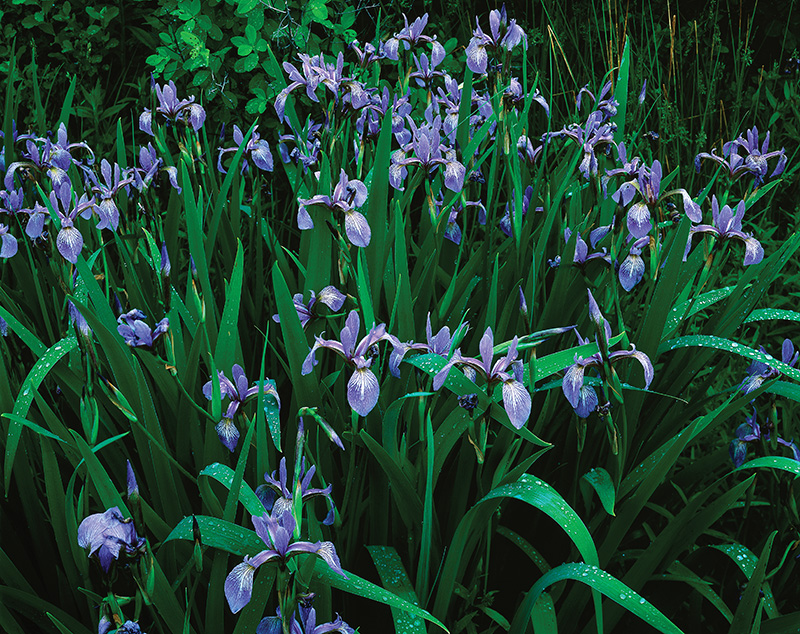
Large Blue Flags, Ellsworth, Maine, June 1982 © William Burt.
Pittsburg: it’s the name of not only the town, but the whole northern spear tip of New Hampshire—all 291 square miles—and therein lie the four Connecticut Lakes, from which the river flows. The ultimate source, the Fourth Connecticut, is snugged among the hills just a few minutes’ hike downhill from the Canadian boundary at Chartierville, Quebec. At a mere two acres, I’d heard say, it’s really no more than a beaver pond.
But what’s it like up there, in that far northern Neverland where the Connecticut River rises? The flora, fauna, and the very ambience…is it so very different at the one end of the river from the other?
To one who hails from the far southern end, and first sets out to see its northern reaches back in the late ’70s, it was soon clear that this was quite another Eden. I was ceding the oak-hemlock woods of home for spruce and fir, and the Spartina marshes and King Rails for boggy ponds, Gray Jays, and Olive-sided Flycatchers. And thus it was with the wildflowers too, most strikingly: I’d forfeited Sea Lavenders and Rosemallows for Bunchberry, Clintonia, and Labrador Tea.
And mammals? I can’t say that I met with any slavering bears, but my first drive up along Route 3 had nearly trimmed the whiskers of a huge bull moose as it emerged from roadside hobblebush (and in so doing nearly scared the wits out of my poor friend Judy, who as passenger sat that much closer).
So yes, I’d say it’s very much a different river at the northern end. It is another world entirely.
![]() My visits to the region were born both of curiosity—those four lakes were the source of my home river after all, and I was eager to dig in, explore, and see what lurked—and of a fierce desire to photograph. I was still learning to employ the acrobatic features of my big new view camera (you know, the Ansel Adams kind) and keen to find new territory, and new subjects; and the best of subjects for that four-by-five-inch sheet of film, I’d learned, are often found in the wildflowers at your feet.
My visits to the region were born both of curiosity—those four lakes were the source of my home river after all, and I was eager to dig in, explore, and see what lurked—and of a fierce desire to photograph. I was still learning to employ the acrobatic features of my big new view camera (you know, the Ansel Adams kind) and keen to find new territory, and new subjects; and the best of subjects for that four-by-five-inch sheet of film, I’d learned, are often found in the wildflowers at your feet.
Indeed, what most impressed me from the first in this fir-scented northland was how utterly its flora differed from my own down in Connecticut. On my first visit, only two familiar species had jumped out at me: the blazing yellow-flowering Marsh Marigold, abloom in the wet meadow grass along a roadside stream; and then the showy Large Blue Flag, in a lone clump along the boggy shoreline of East Inlet just above the Second Lake. And after that, they were all new.
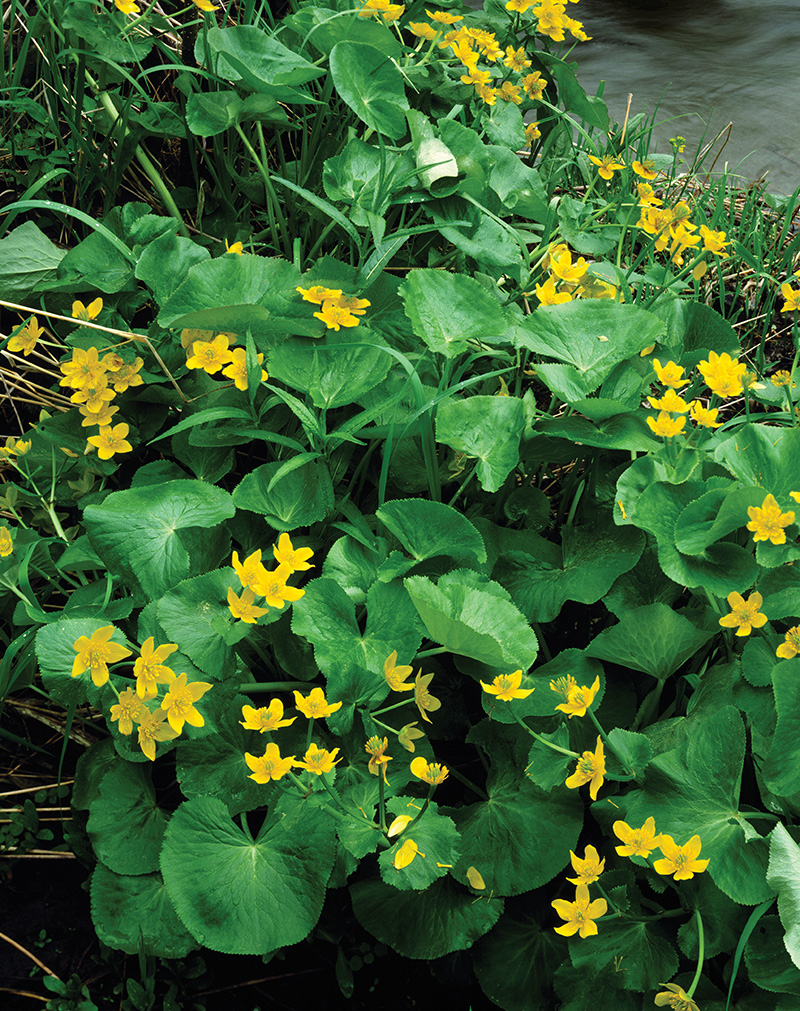
Marsh Marsigolds, Colebrook, New Hampshire, May 1979 © William Burt
One of the first to appear in any numbers was Clintonia, a handsome plant with sheeny basal leaves and a lone yellow bell upon a stalk. Another was the fancy dogwood-flowered Bunchberry, whose big white blossoms look like they belong up in the branches of a tree—and well they might, as it’s a member of the dogwood family—and another still the sprightly Common Wood Sorrel, or Oxalis. Its veined white or pinkish flowers seldom showed themselves (to me, at least), but there’s no overlooking the three heart-shaped leaflets, which recall the clover leaves of one’s backyard: they green the forest floor in numbers like no others.
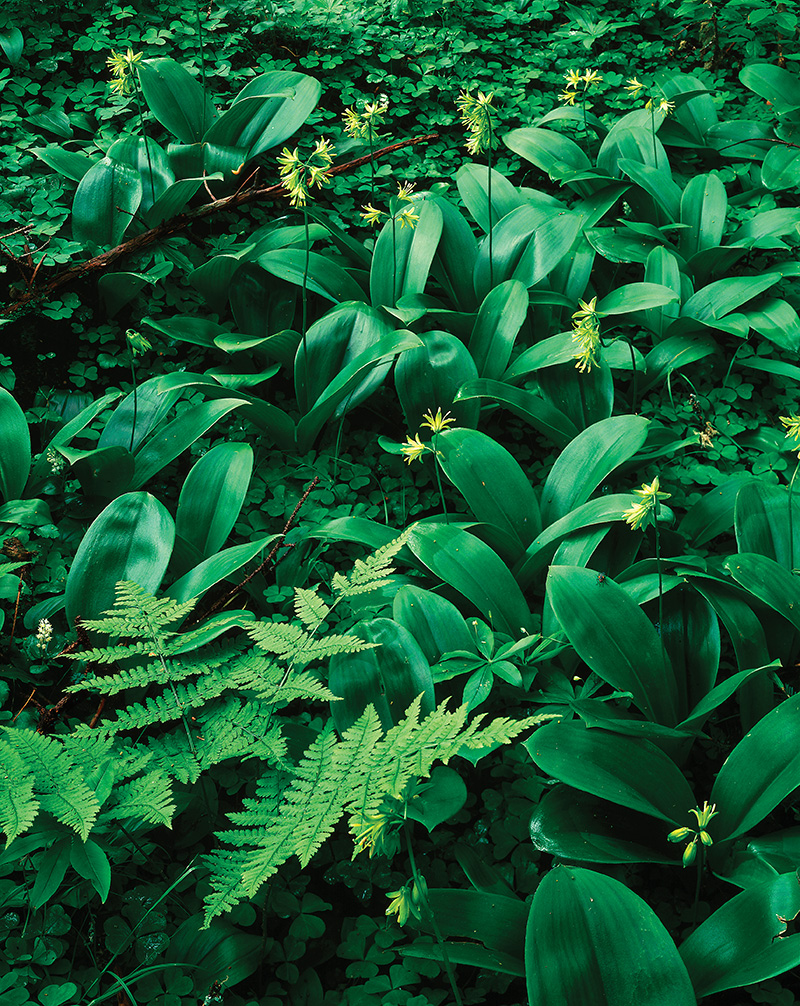
Clintonias and Woodferns, Pitttsburg, New Hampshire, June 1978 © William Burt
These three were far the most abundant species of the Pittsburg woods in June. Some few others popped up here and there—Twinflower, Goldthread, and Canada Anemone come to mind—but not in any numbers. Yet when I returned a few weeks earlier one year, in about mid-May, the woods were rife with the bright white-and-crimson blooms of Painted Trillium. I’d never seen the plant before, so it was always a surprise to come upon these beauties when the forest was still cold and empty otherwise.
![]() Upon arriving, my first destination with a camera was the Fourth Connecticut Lake.
Upon arriving, my first destination with a camera was the Fourth Connecticut Lake.
I parked at the border station, scrabbled up along the rocky boundary line to a blue blaze, turned south, and stepped on down through a dim fairyland woods of spruce and lichen-plastered boulders, and uncanny stillness. A Gray Jay peered down from its nest of sticks then turned away, indifferent to the young man passing underneath; and then before I knew it the trail stopped abruptly at the shore of a small lake—or pond. It was indeed a beaver pond, quite literally. At the far end was a dam of heaping branches, sticks, and gnawed-off trunks: a major feat, no question; yet the water raced on through beneath in sheets, and spilled on downhill through the forest to the next lake in the chain: the Third Connecticut.
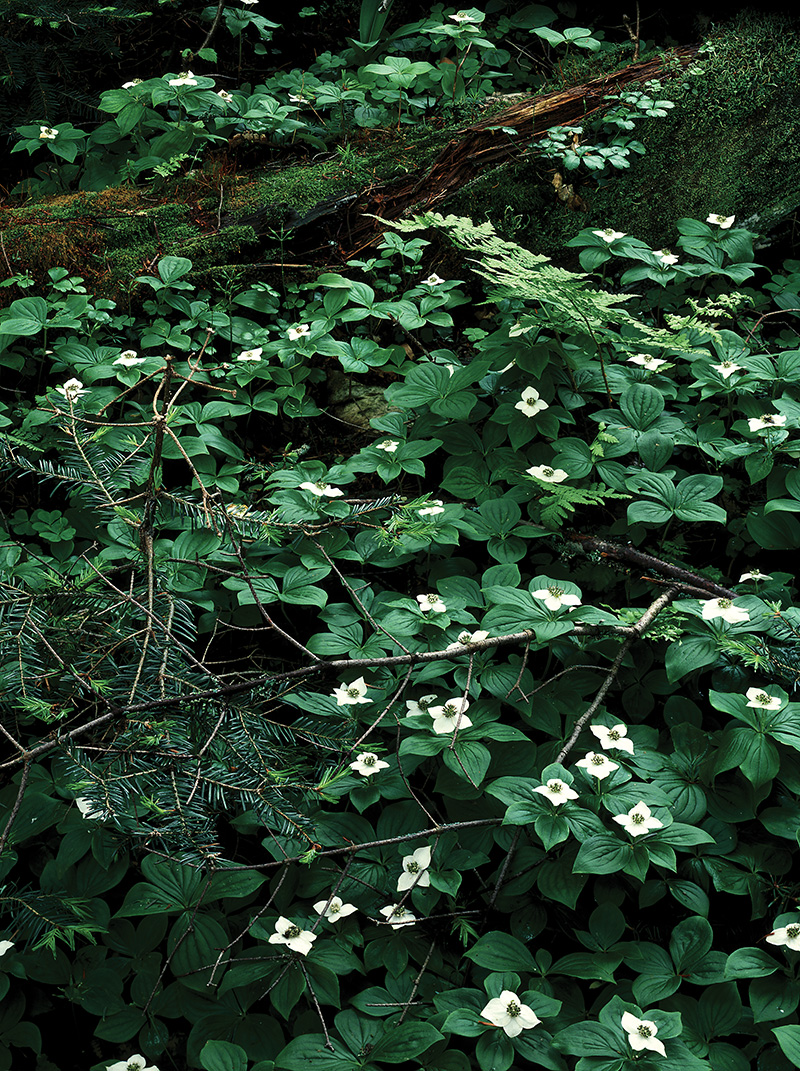
Bunchberry & Fallen Fir, Pitttsburg, New Hampshire, June 1978 © William Burt
One day I followed this first stretch of the Connecticut for most of its brief tumble from the Fourth Lake to the Third, and it was less a river really than a robust brook. In places, I could actually straddle it. So it was fun to see this first half mile of the long river, but…where were the flowers, and the photographs? These woods were oddly unaccommodating to a chap who’d hauled his camera all this distance, and that was a disappointment. But no matter; I’d already had another hike in mind.
![]() Far up a feeder stream above the Second Lake, so I’d been told, stood the last virgin tract of lowland spruce-fir forest in New Hampshire, if not all New England. The 125-acre stand was venerated for its 80-foot Balsam Firs and 90-foot Red and Black Spruces, and for the plush mosses flourishing beneath. The St. Regis Paper Company had owned the property but kept hands off, thank goodness; and would bequeath it to the care of the Nature Conservancy in the mid 1980s.
Far up a feeder stream above the Second Lake, so I’d been told, stood the last virgin tract of lowland spruce-fir forest in New Hampshire, if not all New England. The 125-acre stand was venerated for its 80-foot Balsam Firs and 90-foot Red and Black Spruces, and for the plush mosses flourishing beneath. The St. Regis Paper Company had owned the property but kept hands off, thank goodness; and would bequeath it to the care of the Nature Conservancy in the mid 1980s.
So, this was my next imperative: to see the ancient trees and mosses, and, I hoped, great galleries of flowers.
It was tough slogging, but I soldiered on, found the appointed trail blaze, and turned south, then bulled my way in through a wall of spindly birches and mixed undergrowth, and on into the gloom; and there among the rising trunks, chest-deep in woodferns, I felt very small. A few yards farther in the ferns gave way to mats of Sphagnum moss and scattered Bunchberry, a few Clintonias, and everywhere the elfin leaves of the Oxalis, or Wood Sorrel; and that was about all. I’d fancied wading out through swells of colors, and wildflowers such as I had never seen, or photographed; but flowers needed sunlight, after all, and this was virgin forest.
A sea of green flowed up and over the long-fallen hulks, while those less old were heaped with mosses—fern mosses, mostly—and in the deep forest shade they glowed, both green and yellow-green. A bryologist (e.g., a botanist of mosses) would be in heaven here, in these old woods. But something else impressed me too in there among the mighty trunks: the silence. Now and then I heard a flexing creak from somewhere high above, or the ghost-whisper of a breeze; and once or twice the tin-horn toots of a Red-breasted Nuthatch; but nothing more.
Speaking of birds…they are a bit off-subject here, but I’m reminded of a boyhood hero who had come to Pittsburg several years before, intent on photographing certain birds found in the area.
During one of my June stays at the Scott Cabins years ago I’d learned that a Fred Scott had hired out as a guide to the great naturalist-photographer Eliot Porter, to assist him in locating nesting territories of some northern species—and in particular, the Blackpoll Warbler. So, Fred Scott: might he have been related to these folks? I walked up to the main cabin, found an elder Mrs. Scott at the reception desk, and asked.
“Why yes, that would be Fred,” she replied with rather businesslike exactitude; and yes, she said, when he got back from town, he would be glad to talk with me. And sure enough, within the hour his face was at my cabin door with a big smile: a little shy, but eager to talk.
“Oh, yes, Mr. Porter,” he said in his slow gentle way. “Oh, I liked him. He was an interesting man!” Fred’s proudest moment was in showing Porter the live nest of a Northern Three-toed Woodpecker.
“Yes, I liked him,” Fred said again with eyes alight; and I liked Fred.
![]() I had one other wilderness of flora to explore: not in the woods again, or anywhere about the lakes or ponds, but in those soggy in-between lands known as bogs. And not in May, but June.
I had one other wilderness of flora to explore: not in the woods again, or anywhere about the lakes or ponds, but in those soggy in-between lands known as bogs. And not in May, but June.
For years I’d been impressed by Eliot Porter’s penned impressions of a northern spruce bog: its “billowy open surface,” and its “dense white blossoms…dazzling as frost”; and I could hardly wait to get my boots mucked up and see what I could see, and photograph, in those New Hampshire bogs. But I soon found that what the maps and signs called “bogs”—Scott Bog, Big Brook Bog, Coon Brook Bog, and so on—were not bogs at all but ponds, if sometimes fringed by a few yards of boggy mat. It seemed that these and others had once been true bogs, but that then sometime early in the century the region’s brooks and streams (and the river itself) had all been dammed, in a campaign to improve the local fishing and boating, and attract vacationers.
So, that was a disappointment too. But then one day I found one: a real bog.
I’d stopped along Rte. 3 across from Second Lake, and noticed what appeared to be an open space back in among the spruces; so I marked an entry point and pried my way in through to find a mossy bog, no bigger than a tennis court or two but plush, untouched, and pretty as you like. And as this was the only such true bog I’d found about these four Connecticut Lakes, you can be sure that I’d be giving it a right good going over.
The Sphagnum was itself enchanting—pure green through-and-through and spongy, flocculent, and pillowy in places—but a garden needs its flowers, and my camera did as well. Where were they all?
The first I saw were those strange rubbery contraptions known as Pitcher Plants, whose red and green veined tubes invite the unsuspecting insect to a rain-filled pit of no return (a “pitfall trap,” it’s called), and a long soaking course of chemical digestion. The dull red flower hangs aloft upon an independent stalk, and it’s a cheesy piece of work: the crude botanical equivalent of velvet art. At one end of the bog these plants erupted from the moss in clumps, and little else appeared nearby; though they might well have been accompanied by tiny sundews: I can’t recall.
I’d hoped to find at least one of the pink bog-loving orchids—Arethusa, Calopogon, Rose Pagonia?—but it seemed these mosses were more suited to the smaller, subtler characters, whose beauty is expressed in microcosms. Creeping Snowberry, for one; its wiry stems are strung with tiny die-cut oval leaves in alternating pairs, as if along a necklace. I saw only a few of the minute white flower bells; but those neat little ovals, with the die-cut edges: they were the thing. The pert white flower of a Goldthread popped up here and there upon a three-inch stalk, and if I leaned in close I could make out the sharp-tined shoots of Haircap Moss; and that was about all, except for the odd whorl of Bunchberry leaves, sans flower. So no, there wasn’t much worth photographing here it seemed, for all the plushy Sphagnum. But I so liked this mossy sanctum: would it not allow me something worthy of the camera?
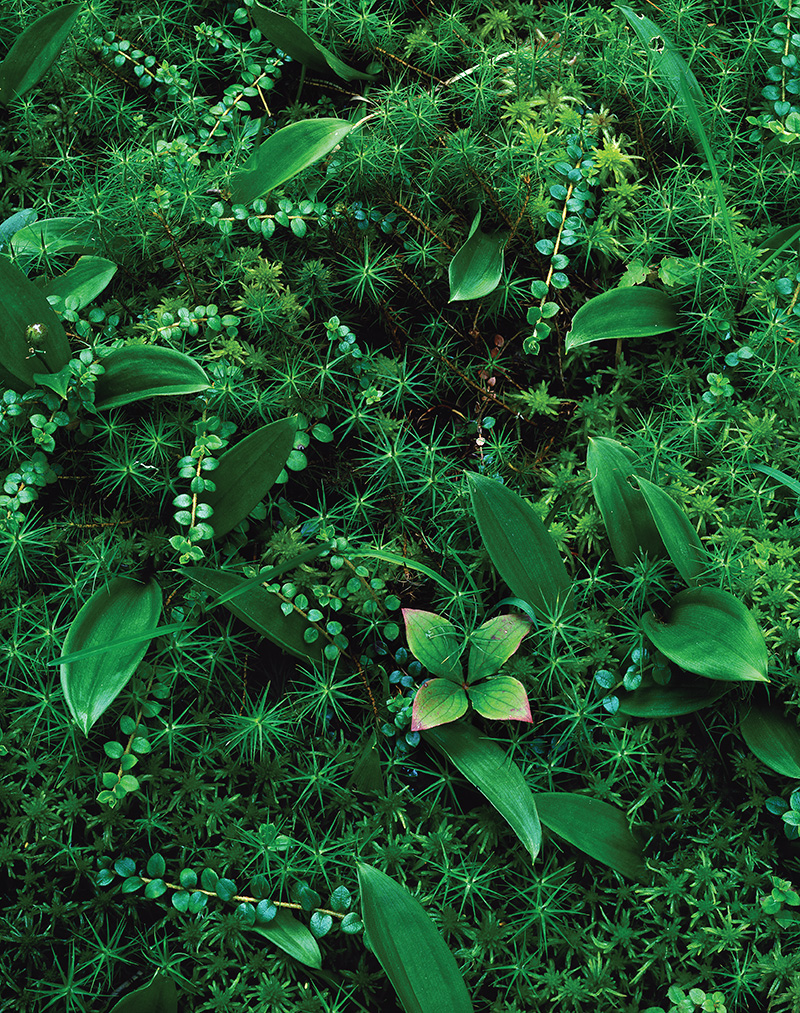
Creeping Snowberry on Sphagnum, Pitttsburg, New Hampshire, July 1981 © William Burt
It would. In a small open area I found the Sphagnum strewn with bursts of roughly half a dozen tiny bright white flowers each; and beneath each burst were the three tapered leaf blades of a winsome little plant called Three-leaved False Solomon’s Seal.
A little plant, indeed. The heights of other so-called Solomon’s Seals, both “False” and otherwise, are expressed in feet; but this one stood a mere three inches tall, or maybe four. So if you weren’t attending to what lay before your feet you’d either overlook it, or dismiss it as the commonplace Wild Lily-of-the-Valley—which abides not in the bogs, but the dry uplands. And then this “Three-leaved” species does have the three leaves, not two; and they are nicely tapered at both ends: as if designed with a fine eye for English cutlery.
Was there a photograph in there? I stepped in close and scanned the scene from several viewpoints, but I wasn’t sure: was all the green too much, too vacant, and the tiny whites too tiny? I feared so. But when I stepped around, leaned down and eyed them from the other side, I saw a nice tight cluster of some 20 plants in flower, all cascading toward me down a two-by three-foot rectangle of bog…I backed off carefully, and scurried back out to the car for the big camera.
I set the tripod, noted down some meter readings, then set up the camera and kneeled down upon the Sphagnum, oozed in deep and felt the cold come through. All set: I burrowed in under the focusing cloth, composed and focused, and then recomposed, refocused, and set aperture and shutter speed; then took a final look to see those tiny whites come tumbling down across the screen in bunches, like spilled stars.
And in my own good time then I exposed four sheets, each with a quarter-stop adjustment: those bright whites would have to be just right.

